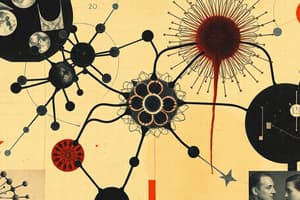Podcast
Questions and Answers
If an atom has 6 valence electrons, what charge would its most common ion have?
If an atom has 6 valence electrons, what charge would its most common ion have?
Which of the following best describes the function of the endoplasmic reticulum in a cell?
Which of the following best describes the function of the endoplasmic reticulum in a cell?
What happens to a ray of light when it travels from a material with a low refractive index to one with a high refractive index?
What happens to a ray of light when it travels from a material with a low refractive index to one with a high refractive index?
Which of the following is the most significant anthropogenic cause of increasing levels of greenhouse gases?
Which of the following is the most significant anthropogenic cause of increasing levels of greenhouse gases?
Signup and view all the answers
In a balanced chemical equation, what must be the same on both sides of the reaction?
In a balanced chemical equation, what must be the same on both sides of the reaction?
Signup and view all the answers
Signup and view all the answers
Flashcards
Mitosis
Mitosis
The process by which a cell divides into two identical daughter cells, ensuring the accurate replication of genetic material and maintaining the original cell's functions.
Indicator
Indicator
A substance that changes color in the presence of an acid or a base, indicating the pH of a solution.
Refraction
Refraction
The bending of light as it passes from one medium to another, due to a change in the speed of light.
Neutralization reaction
Neutralization reaction
Signup and view all the flashcards
Climate Change
Climate Change
Signup and view all the flashcards
Study Notes
SNC 2D Exam - January 29, 2025
- Date: Wednesday, January 29, 2025
- Time: 8:10 AM - 10:10 AM
- Room: C316
- Materials Allowed: Scientific calculator only; no cell phones or other electronics
Exam Format
- 45 multiple choice questions
- 10 diagram questions
- 35 short answer questions
Chemistry
- Periodic table organization (metals vs. non-metals, groups, valence electrons/ions)
- Dot diagrams (atoms & ions)
- Molecular & ionic compounds (types of bonds, naming, formulas, what they form between)
- Writing chemical reactions (reactants vs. products)
- Types of reactions
- Counting atoms
- Balancing equations
- Acids & bases (identifying, neutralization reactions, pH scale, indicators)
Biology
- Organelles (plant vs. animal cells, function of organelles)
- Characteristics of living things
- Cell division (reason, mitosis, cancer)
- Hierarchy of organization
- Tissues in animals and plants
- Human systems (digestive, respiratory, circulatory, nervous, musculoskeletal; interaction between systems)
Optics
- Luminous vs. non-luminous objects
- Types of light production
- Reflection (terms, law, images produced in plane and curved mirrors, drawing ray diagrams)
- Refraction (n=c/v, bending of light and density of material, Snell's law)
- Lenses (converging vs. diverging, ray diagrams)
- The eye
Climate Change
- Greenhouse effect
- Greenhouse gases
- Evidence
- Anthropogenic causes
- Natural causes
- Taking action
Studying That Suits You
Use AI to generate personalized quizzes and flashcards to suit your learning preferences.
Description
Test your knowledge on fundamental science concepts including atomic structure, cell functions, light behavior, environmental issues, and chemical equations. This quiz covers essential topics in chemistry and biology, challenging you to think critically about these subjects.




